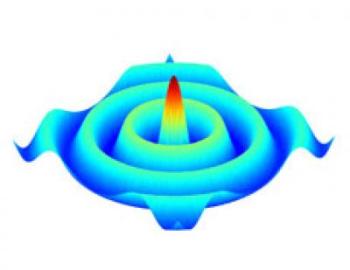Theoretical predictions about nanoscale spin waves have been experimentally confirmed by a research team at the Royal Institute of Technology and the University of Gothenburg, paving way for the replacement of microwave technology with nanoscale, inexpensive components that need minimum resources in most of the applications, including wireless networks and mobile phones.
 Spin waves spread from a magnetic nanocontact like rings on water.
Spin waves spread from a magnetic nanocontact like rings on water.
The objective of the research project was to reveal the transmission of spin waves from magnetic nanocontacts. Using electrical devices, the research team confirmed the existence of spin waves last autumn. The team has employed a sophisticated spin wave microscope at the laboratory of the University of Perugia in Italy to view the motion.
The researchers were able to observe the components’ dynamic properties at a resolution of nearly 250 nm using the special microscope. The findings have paved the path for a new kind of research field called ‘magnonics’ utilizing nanoscale magnetic waves.
According to Johan Åkerman, who serves at the Department of Physics of the University of Gothenburg as well as the head of the Applied Spintronics group, the findings will lead to the quick advancement of magnonic circuits and components. The fact that a simple direct current is enough to power these components and that current is subsequently converted at the microwave region to spin waves at the microwave region is amazing, he said. The current can directly control the waves’ frequency, resulting in new capabilities, he added.
The magnonic technology’s metallic and magneto-optical properties allow it to be added to conventional microwave-based electronic circuits, resulting in the development of new technologies. Magnonic components are ideal for miniaturization compared to conventional microwave technology.